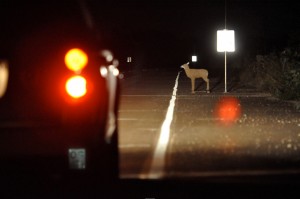
Ever since agencies started using uniform traffic signs, the conventional thinking concerning nighttime visibility is that brighter is better. But a recent Texas A&M Transportation Institute (TTI) research project revealed that signs along rural highways can be so bright that they cause disability glare to the point of reduced hazard detection distances, which can be a significant safety concern.
The project, sponsored by the Federal Highway Administration (FHWA) and the Texas Department of Transportation, provided a unique opportunity for TTI Senior Research Engineer Paul Carlson to study a different aspect of retroreflective signage.
“This process started when FHWA published rulemaking on minimum maintenance requirements for traffic signs based on retroreflectivity — how bright signs needed to be to meet drivers’ needs,” explained Carlson. “During this time, there were some technology changes in the market and manufacturers and contractors started pushing for brighter signs while agencies were replacing those that were not in compliance with the minimum retroreflectivity rule. As a result of these brighter signs, we started hearing some complaints from agencies throughout the country asking if these signs can be too bright. And that’s never really been asked before, to my knowledge.”
According to Carlson, if signs are too bright there may be a loss of legibility or create a glare that limits the ability to see potentially hazardous objects near or on the road.
The researchers conducted the study by recruiting participants and conducting nighttime visibility studies on a closed-course facility at the Texas A&M University Riverside Campus. They then assessed how various levels of Speed Limit sign brightness can impact nighttime participants’ ability to read the Speed Limit signs and detect various types of potentially hazardous objects along the edge of the traveled way.
“After our research was conducted, we found that signs can be too bright,” said Carlson. “Interestingly, we found that legibility does not diminish; rather the brightest signs used in our study were correlated with the shortest detection distances with pedestrians, deer and other roadside obstacles that nighttime drivers would want to see. In other words, the brightest signs reduce the nighttime detection distance of obstacles on or near the roadside to the point where it could potentially be hazardous.”
The research team hopes to eventually develop recommendations for maximum retroreflective standards to partner with the minimum retroreflectivity levels that are already established. The team also plans on testing more headlight patterns to better understand how future technologies might impact the safety of nighttime travel.
“Organizations and agencies are interested in maximum retroreflectivity standards as well as guidelines for sign sheeting selection for specific scenarios. This study provides some information for such guidelines but more work is needed,” said Carlson.
For more information about this project, see chapter 3 of Traffic Control Device Evaluation Program: Technical Report.